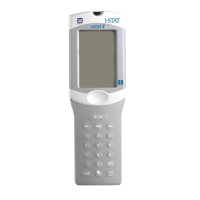Rev. Date: 01-Aug-11 Art: 714178-00L HB - 3
Method Comparison (%PCV)
Coulter
®
S Plus Nova STAT Profile
®
5
Abbott
Cell-Dyn 4000
Sysmex SE9500
n 142 192 29 29
Sxx 0.50 0.46 0.41 0.53
Syy 1.09 1.31 0.77 0.76
Slope 0.98 1.06 1.06 1.11
Int’t 1.78 -3.98 -1.42 -4.19
Sy.x 2.03 2.063 1.13 0.98
Xmin 18 21 19 24
Xmax 51 50 46 47
r 0.952 0.932 0.993 0.980
Factors Affecting Results*
The measurement of certain blood samples with high erythrocyte sedimentation rates (ESR) may be
affected by analyzer angle. While testing blood samples, beginning ninety (90) seconds after the cartridge
is inserted, the analyzer should remain level until a result is obtained. A level surface includes running the
handheld in the downloader/recharger.
Interferent Effect
WBC Grossly elevated white blood cell counts may increase results.
Total Protein Hematocrit results are affected by the level of total protein as follows:
Displayed Result TP < 6.5 g/dL TP > 8.0 g/dL
HCT < 40 %PCV
Hct decreased by ~1% PCV
for each decrease of
1 g/dL TP
Hct increased by ~1% PCV
for each increase
1 g/dL TP
HCT > 40 % PCV
Hct decreased by ~0.75 % PCV
for each decrease of
1 g/dL TP
Hct increased by ~0.75 %PCV
for each increase
1 g/dL TP
Total protein levels may be low in neonatal and burn patient populations, as well
as in additional clinical populations listed in Statland
3
. Total protein levels may also
be decreased in patients undergoing cardiopulmonary bypass (CPB) or ECMO,
and with patients receiving large volumes of saline-based IV fluids. Care should be
taken when using hematocrit results from patients with total protein levels below
the adult reference range (6.5 to 8 g/dL).
The CPB sample type can be used to correct the hematocrit result for the dilutional
affect of the pump prime in cardiovascular surgery. The CPB algorithm assumes
that cells and plasma are diluted equally and that the pump priming solution has
no added albumin or other colloid or packed red blood cells. Since perfusion
practices vary, it is recommended that each practice verify the use of the CPB
sample type and the length of time in which the CPB sample type should be used
during the recovery period. Note that for hematocrit values above 30 %PCV, the
CPB correction is ≤1.5 %PCV; the size of the correction at this level should not
impact transfusion decisions.
Lipids Abnormally high lipids may increase results. Interference from lipids will be about
two thirds the size of the interference from protein.
Sodium The sample electrolyte concentration is used to correct the measured conductivity
prior to reporting hematocrit results. Factors that affect sodium will therefore also
affect hematocrit.
*It is possible that other interfering substances may be encountered. These results are representative and your results may differ somewhat due to
test-to-test variation. The degree of interference at concentrations other than those listed might not be predictable.

